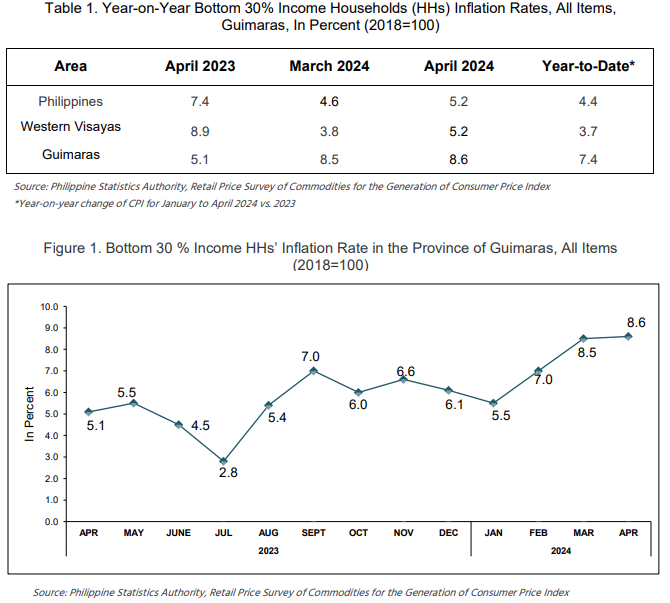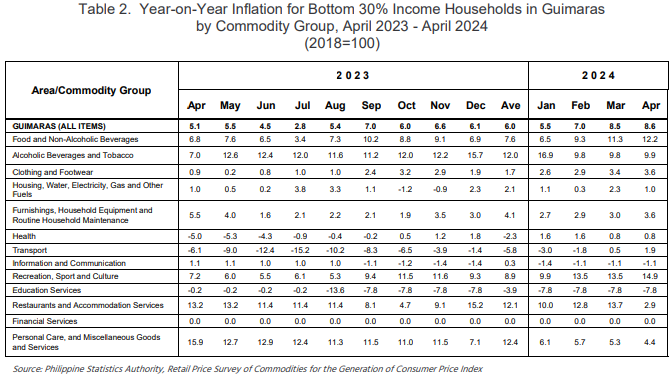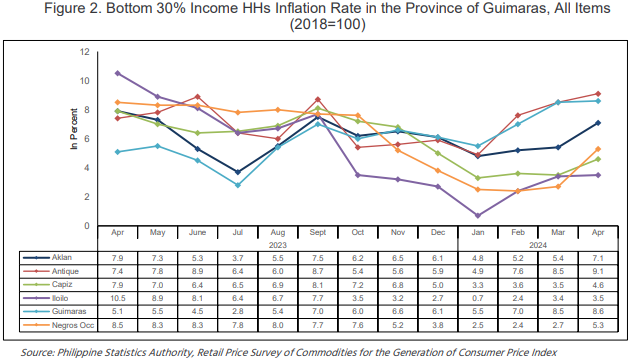
1. Guimaras Inflation for Bottom 30 % Income HHs
The Guimaras’ inflation for the bottom 30 % income HHs soared to 8.6 percent in April 2024 from 8.5 percent in March 2024, bringing the provincial average inflation for low-income from January to April 2024 to 7.4 percent. In April 2023, the said inflation rate was slower at 5.1 percent. (Figure 1 and Table 1)
1.1 Main Drivers to the Upward Trend of the Bottom 30% Income HHs’ Inflation
The uptrend inflation in April 2024 for the low-income HHs was primarily influenced by the faster year-on-year increase in the heavily weighted food and non-alcoholic beverages at 12.2 percent during the month, from 11.3 percent in March 2024. The rapid annual inflation growth rate of Transport at 1.9 percent in April 2024 from 0.5 percent in the previous month also contributed to the uptrend of the overall bottom 30% income HHs’ inflation. Furnishings, household equipment and routine household maintenance also brought a significant share to the overall inflation for low-income HHs in April which is 3.6 percent higher than the 3.0 percent in March 2024.
Food and non-alcoholic beverages (84.0%), Transport (10.8%), and Furnishings, household equipment, and routine household maintenance (2.3%) were the top 3 commodities with a huge share in the low-income inflation trend in April 2024.
In addition, three commodity groups showed quicker inflation rates:
a. Recreation, Sport and Culture, 14.9 percent from 13.5 percent;
b. Clothing and Footwear, 3.6 percent from 3.4 percent; and
c. Alcoholic Beverages and Tobacco, 9.9 percent from 9.8 percent.
In contrast, the following commodity groups registered faster inflation rates during the month:
a. Housing, Water, Electricity, Gas and Other Fuels, 1.0 percent from 2.3 percent;
b. Restaurants and Accommodation Services, 2.9 percent from 13.7 percent;
c. Personal Care, and Miscellaneous Goods and Services, 4.4 percent from 5.3 percent;

Moreover, Health, Information and Communication, Education, and Financial Services retained their previous month’s annual rates. (Table 2)
1.2 Main Contributors to the Bottom 30 % Income HHs’ Inflation
The top three commodity groups contributing to the April 2024 overall inflation were the following:
a. Food and Non-Alcoholic Beverages with 87.7 percent share or 7.54 percentage points;
b. Alcoholic beverages and tobacco with 4.4 percent share or 0.38 percentage points; and
c. Personal Care and Miscellaneous Goods and Services with 1.5 percent share or 0.13 percentage points.
2. Food Inflation for Bottom 30% Income HHs
Food inflation for low-income HHs rose to 12.7 percent in April 2024 from 11.8 percent in March 2024. In April 2023, food inflation for the bottom 30% income HHs was lower at 7.0 percent. (Table 3)

2.1 Main Drivers to the Upward Trend of Food Inflation for Low-income HHs
The acceleration of food inflation for low-income HHs in April 2024 pushed by the yearon-year price increase in the vegetables, tubers, plantains, cooking bananas and pulses index at 13.7 percent in April 2024 from the 2.2 percent annual decline in the previous month. It was followed by fish and other seafood with an inflation rate of 1.0 percent from an annual drop of 2.8 percent in March 2024.
The index of ready-made food and other food products not elsewhere classified also contributed to the uptrend as it recorded a faster annual increase of 19.4 percent during the month from 16.6 percent in March 2024.
Vegetables, tubers, plantains, cooking bananas, and pulses; Fish and other seafood; and ready-made food and other food products not elsewhere classified were the top 3 food items which showed a huge share of the April food inflation for low-income with 52.0%, 42.7%, and 3.8%, respectively.
In addition, a quicker inflation rate in Sugar, confectionery and desserts at -9.5 percent in April 2024 from -10.3 percent in the previous month were observed, also in Oils and fats at -4.9% in April from -5.8 a month ago.
On the contrary, four food groups exhibited slower price changes:
a. Cereals and cereal products, 25.6 percent from 28.2 percent;
b. Meat and other parts of slaughtered land animals, 15.5 percent from 20.9 percent;
c. Milk, other dairy products and eggs, 2.8 percent from 4.8 percent; and
d. Fruits and nuts, -4.3 percent from 5.1 percent
2.2 Main Contributors to the Food Inflation for Low-income HHs
Food inflation shared 85.9 percent or 7.38 percentage points to the overall inflation in April 2024. The top three food groups in terms of contribution to the food inflation during the month were the following:
a. Cereals and cereal products, which include rice, corn, flour, bread and other bakery products, pasta products, and other cereals, with a share of 69.2 percent or 5.95 percentage points;
b. Meat and other parts of slaughtered land animals with a share of 8.7 percent or 0.75 percentage points; and
c. Vegetables, tubers, plantains, cooking bananas and pulses with a share of 5.2 percent or 0.45 percentage points.
3. Bottom 30% Income HHs’ Inflation per province in Region VI

Antique and Guimaras posted the highest low-income HHs inflation among the six provinces in Western Visayas (WV) with 9.1 and 8.6 percent, respectively, followed closely by Aklan with 7.1 percent.
Iloilo reported the lowest inflation for the bottom 30% income HHs in WV, recording 3.5 percent, trailed by Capiz and Negros Occidental with 4.6 and 5.3 percent, correspondingly.
In terms of inflation trend from March to April 2024, the province with the highest inflation increment was Negros Occidental, with 2.60 percentage points growth from 2.7 to 5.3 inflation, followed by Aklan with a lump of 1.70 percentage points from 5.4 to 7.1 inflation, and Capiz with 1.10 percentage points increase from 3.5 to 4.6 inflation.
Antique showed the slowest inflation rate changes with a 0.60 percentage points difference, with 4.6 inflation from 3.5 inflation in March, followed by Guimaras and Iloilo, which showed 0.10 percentage points change with 8.6 and 3.5 inflation in April from 8.5 and 3.4 inflation a month ago, correspondingly.
Meanwhile, from January 2024 to April 2024, all provinces posted an erratic movement on their headline inflation rate except for the provinces of Aklan, Antique, and Iloilo, which posted an upward trend. (Figure 2.)

